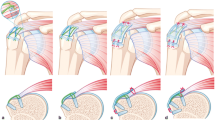Abstract
Both mechanical and biological factors influence the high re-tear rate after rotator cuff repair. Mechanical factors have largely been addressed by the introduction of better implants and modification of suture configuration, but further improvements are needed to address the often poor tissue quality of the degenerated rotator cuff tendons. Current biological solutions provide only short-term reinforcement and have been associated with pseudo-infectious reactions. This pre-clinical animal study investigates the biological response to a novel polycarbonate polyurethane patch used for tissue augmentation in a rat rotator cuff repair model. Bilateral defects were created in the supraspinatus tendons of 12 Sprague Dawley rats. One side was repaired with a patch as a tissue augmentation device. The contralateral side acted as internal control without patch augmentation. After 6 weeks the tissues were harvested and underwent histologic and histomorphometric analyses. Histological evaluation demonstrated no inflammatory reaction; histomorphometry revealed tissue ingrowth of 79.9%. In conclusion, the polycarbonate polyurethane patch for tissue extension or augmentation in rotator cuff repair has demonstrated no inflammatory response and excellent tissue integration in a rat rotator cuff repair model.




Similar content being viewed by others
References
Williams GR Jr, Rockwood CA Jr, Bigliani LU, Iannotti JP, Stanwood W (2004) Rotator cuff tears: why do we repair them? J Bone Joint Surg Am 86-A(12):2764–2776
Galatz LM, Griggs S, Cameron BD, Iannotti JP (2001) Prospective longitudinal analysis of postoperative shoulder function: a ten-year follow-up study of full-thickness rotator cuff tears. J Bone Joint Surg Am 83-A(7):1052–1056
Gazielly DF, Gleyze P, Montagnon C (1994) Functional and anatomical results after rotator cuff repair. Clin Orthop Relat Res 304:43–53
Gerber C, Fuchs B, Hodler J (2000) The results of repair of massive tears of the rotator cuff. J Bone Joint Surg Am 82(4):505–515
Harryman DT II, Mack LA, Wang KY, Jackins SE, Richardson ML, Matsen FA III (1991) Repairs of the rotator cuff. Correlation of functional results with integrity of the cuff. J Bone Joint Surg Am 73(7):982–989
Galatz LM, Ball CM, Teefey SA, Middleton WD, Yamaguchi K (2004) The outcome and repair integrity of completely arthroscopically repaired large and massive rotator cuff tears. J Bone Joint Surg Am 86-A(2):219–224
Zheng MH, Chen J, Kirilak Y, Willers C, Xu J, Wood D (2005) Porcine small intestine submucosa (SIS) is not an acellular collagenous matrix and contains porcine DNA: possible implications in human implantation. J Biomed Mater Res B Appl Biomater 73(1):61–67
Sclamberg SG, Tibone JE, Itamura JM, Kasraeian S (2004) Six-month magnetic resonance imaging follow-up of large and massive rotator cuff repairs reinforced with porcine small intestinal submucosa. J Shoulder Elbow Surg 13(5):538–541
Langer C, Schaper A, Liersch T, Kulle B, Flosman M, Fuzesi L, Becker H (2005) Prognosis factors in incisional hernia surgery: 25 years of experience. Hernia 9(1):16–21
Hirooka A, Yoneda M, Wakaitani S, Isaka Y, Hayashida K, Fukushima S, Okamura K (2002) Augmentation with a Gore-Tex patch for repair of large rotator cuff tears that cannot be sutured. J Orthop Sci 7(4):451–456
Lelah M, Cooper S (1986) Polyurethanes in medicine. CRC Press, Boca Raton, FL
Stokes K, McVenes R, Anderson JM (1995) Polyurethane elastomer biostability. J Biomater Appl 9(4):321–354
Stokes K (1987) Polyurethanes in biomedical engineering II. Elsevier Science Publishers, Amsterdam, NL
Kimura A, Aoki M, Fukushima S, Ishii S, Yamakoshi K (2003) Reconstruction of a defect of the rotator cuff with polytetrafluoroethylene felt graft. Recovery of tensile strength and histocompatibility in an animal model. J Bone Joint Surg Br 85(2):282–287
Gimbel JA, Van Kleunen JP, Mehta S, Perry SM, Williams GR, Soslowsky LJ (2004) Supraspinatus tendon organizational and mechanical properties in a chronic rotator cuff tear animal model. J Biomech 37(5):739–749
Carpenter JE, Thomopoulos S, Soslowsky LJ (1999) Animal models of tendon and ligament injuries for tissue engineering applications. Clin Orthop Relat Res 367(Suppl):S296–S311
Soslowsky LJ, Carpenter JE, DeBano CM, Banerji I, Moalli MR (1996) Development and use of an animal model for investigations on rotator cuff disease. J Shoulder Elbow Surg 5(5):383–392
Gimbel JA, Mehta S, Van Kleunen JP, Williams GR, Soslowsky LJ (2004) The tension required at repair to reappose the supraspinatus tendon to bone rapidly increases after injury. Clin Orthop Relat Res 426:258–265
Author information
Authors and Affiliations
Corresponding author
Rights and permissions
About this article
Cite this article
Cole, B.J., Gomoll, A.H., Yanke, A. et al. Biocompatibility of a polymer patch for rotator cuff repair. Knee Surg Sports Traumatol Arthrosc 15, 632–637 (2007). https://doi.org/10.1007/s00167-006-0187-6
Received:
Accepted:
Published:
Issue Date:
DOI: https://doi.org/10.1007/s00167-006-0187-6




